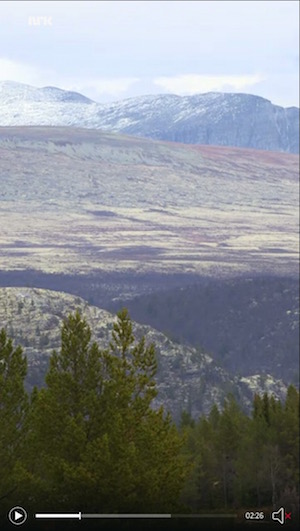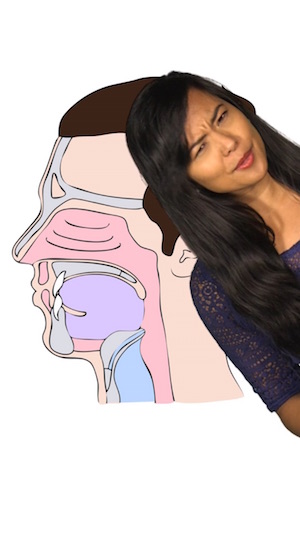
Hiking through the hills above Otta, Norway, a town of 1,700 about a four-hour drive north of Oslo, a team from the Norwegian public broadcaster NRK realized it would have to take a new approach to filming the vistas for the interactive documentary it was creating.
 As part of a company-wide effort to improve mobile strategy, the documentary — which focused on how Otta was adapting to a refugee center that opened in a shuttered hotel — was filmed vertically, using a camera rotated 90 degrees to the side. Staffers built a special grip to hold the camera steadily sideways.
As part of a company-wide effort to improve mobile strategy, the documentary — which focused on how Otta was adapting to a refugee center that opened in a shuttered hotel — was filmed vertically, using a camera rotated 90 degrees to the side. Staffers built a special grip to hold the camera steadily sideways.
“When you go up to the Norwegian mountains, it’s really beautiful, and you’re used to seeing the landscape in horizontal mode,” NRK’s Kim Jansson, who led the project, told me.
“You need to adjust your way of thinking. ‘OK, we need to cut off the left and right sides, what can we do to make it work vertically?’ We used trees to make people see how tall things are: How big the mountains are, how tall the buildings are,” he said. “You can get a different perspective. You just have to change your mind a little bit to see the opportunities that you don’t have when you’re filming horizontally.”
As mobile consumption continues to grow, news outlets — especially those publishing on Snapchat Discover — are turning to vertical video, a format that was once widely derided, to optimize their content for viewing on phones.
According to analyst Mary Meeker, users use vertically oriented devices nearly 30 percent of the time, up from just 5 percent in 2010. And more than 7 billion videos are viewed each day on Snapchat, which is specifically designed for vertical consumption.
But even as outlets ranging from National Geographic to Mashable and Vox create vertical videos, there’s no consensus on the best way to actually produce them. Some organizations, such as NRK, decided to rotate their cameras and film vertically, while others have decided to shoot the traditional horizontal way and then adapt the footage to fit a vertical screen.
While shooting vertically can present simple logistical problems (what’s the best way to secure a camera sideways on a tripod?), the unorthodox orientation forces producers to alter their shot compositions and techniques regardless of how the video is shot.
“The apparatus is a bit of a stumbling block for anyone trying to use a traditional camera to create vertical video,” said Adam Sébire, the co-founder of the Vertical Film Festival in Australia, which has published a guide to filming vertically.
Beyond simply creating the video, presenting it can be a challenge. NRK’s existing video player didn’t accommodate vertical video, so its developers had to quickly build a new player specifically for the refugee film. YouTube just last summer updated its mobile apps to allow for vertical playback that takes up the whole screen.
Snapchat’s seamless handling of vertical video is one reason publishers are focusing their efforts on that platform. National Geographic was one of the original publishers on Snapchat Discover, but it wasn’t until this past September that it committed to presenting all of its Snapchat videos vertically, said James Williams, National Geographic’s director of digital video.
 National Geographic has repurposed some horizontal video for Snapchat, but it’s also shooting some videos, like a regular quiz show, in vertical. Once Williams got over the mental block of “shooting video in the same dimensions that my mom shoots video of her dog in her backyard,” the digital team had to figure the best way to frame stories vertically.
National Geographic has repurposed some horizontal video for Snapchat, but it’s also shooting some videos, like a regular quiz show, in vertical. Once Williams got over the mental block of “shooting video in the same dimensions that my mom shoots video of her dog in her backyard,” the digital team had to figure the best way to frame stories vertically.
“As you come up through your career, you get used to communicating within certain dimensions,” Williams said. “You learn to use that space in a very effective way, in terms of how you balance the shot compositions or place the subject in focus. To suddenly lop off the sides and have to completely rethink how you’re framing things — to me, that was the largest challenge. There was a period of experimentation and the feeling of relief that we can still tell great stories in new dimensions.”
For the videos it films vertically, National Geographic mounts the camera on its side, but there is no leeway to edit the video or change its dimensions. Meanwhile, a horizontally filmed video that is edited into the vertical format can be used for multiple purposes. “It’s a commitment,” Williams said.
 Mashable has decided its best bet is to just film horizontally. In its early days on Snapchat Discover, Mashable tried filming vertically by using a phone camera and by flipping a DSLR camera sideways. Later, it decided to shoot all its videos on a camera that’s oriented horizontally, said Mashable creative director Jeff Petriello.
Mashable has decided its best bet is to just film horizontally. In its early days on Snapchat Discover, Mashable tried filming vertically by using a phone camera and by flipping a DSLR camera sideways. Later, it decided to shoot all its videos on a camera that’s oriented horizontally, said Mashable creative director Jeff Petriello.
“In terms of quality, and for the content to live on in as many forms as possible, shooting it on at least a 4K camera horizontal has proven to be the most efficient,” he said.
Petriello estimated that only a third of the vertical content Mashable creates actually requires a camera. The rest is created through animation and design using programs such as Adobe After Effects.
Vox also predominantly uses animations for its Snapchat Discover channel, and Yvonne Leow, Vox’s senior Snapchat editor, said there’s been “a bit of a learning curve” as Vox’s designers figured out the best ways to create graphics or other visualizations for a vertical screen.
When it does use live video on Snapchat Discover, Vox shoots horizontally. If Vox is shooting an in-studio interview, the videographer will frame the subject in the center of the frame so the video can be easily readjusted to a vertical orientation.
Vox also lays graphics over its interviews, and by using a center-focused shot, it’s able to adapt the graphics to the orientation of the final version.
The New York Times took this approach last year when it produced a video about the collaboration by Justin Bieber, Skrillex, and Diplo. It produced three different versions of the video — a 16:9 ratio for its own player and YouTube, 3:4 for tablets, and 9:16 for a vertical orientation on phones — and adjusted the graphics for each view.Figuring out the best way to present vertical video on screens that aren’t phones can take a little ingenuity.
Mashable has published a handful of vertical videos outside of Snapchat Discover, and when they’re viewed on desktop, those videos are embedded in the left-hand column of a story.
For its interactive about the refugees, NRK, the Norwegian broadcaster, showed large quotes next to the vertical video when it was viewed on desktop.
But NRK estimated that 66 percent of viewers watched the videos on mobile, and the interactive was one of NRK’s most-consumed stories of 2015, even though it wasn’t published until the last week of December.
Jansson’s team is heading back into the field this month to begin its next vertical documentary. This time, they’ll try to add more motion into the video.
“There wasn’t a lot happening in the videos last time around,” he said. “We’re going to see if it’s possible to make that work a little bit better this time. But we’re going to do more or less the same thing. We’ve only done this once through, and we need more practice.”